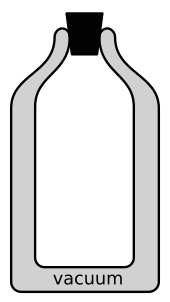
Back Fa^soay a tananoman AMI كظيمة Arabic Termu AST Termos Azerbaijani Тэрмас Byelorussian Термос Bulgarian থার্মোফ্লাস্ক Bengali/Bangla Vakuumska boca BS Termos Catalan Termoska Czech




A vacuum flask (also known as a Dewar flask, Dewar bottle or thermos) is an insulating storage vessel that slows the speed at which its contents change in temperature. It greatly lengthens the time over which its contents remain hotter or cooler than the flask's surroundings by trying to be as adiabatic as possible. Invented by Sir James Dewar in 1892, the vacuum flask consists of two flasks, placed one within the other and joined at the neck. The gap between the two flasks is partially evacuated of air, creating a near-vacuum which significantly reduces heat transfer by conduction or convection. When used to hold cold liquids, this also virtually eliminates condensation on the outside of the flask.
Vacuum flasks are used domestically to keep contents inside hot or cold for extended periods of time. They are also used for thermal cooking. Vacuum flasks are also used for many purposes in industry.
© MMXXIII Rich X Search. We shall prevail. All rights reserved. Rich X Search